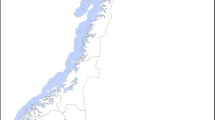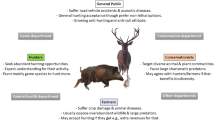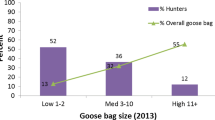Abstract
Maximisation of aggregate recreational hunter benefits involves managing both the prey and the hunter. The biology of game animals, and hence the supply side of the management situation, is reasonably well understood, but there is relatively little information on the demand side. On public lands, where there is no market to signal the quality of the hunting experience, the game manager has little guidance on how to allocate the resource amongst individual hunters. In New Zealand, there is no attempt to do so. Whilst seeing and killing game are known to enhance individual hunters’ benefits, the allocation of the resource across hunters raises the prospect of limiting individual hunter harvests, normally enacted through a bag limit. The benefits of doing so are dependent upon the marginal benefits of different levels of harvest. The relationship between hunter satisfaction and the number of animals killed is explored using data from a longitudinal study of a large panel of deer hunters. Latent class models of satisfaction outperform random parameter models and identify heterogeneous groups of hunters whose satisfaction is differentially dependent on game sightings and harvest. Personal attributes and hunter motivations help explain some of these differences. Heterogeneous and rapidly diminishing marginal satisfaction present a strong case for management of at least part of the open-access New Zealand red deer herd to enhance social welfare by increasing the number of hunters harvesting a deer rather than going home empty-handed.




Similar content being viewed by others
Notes
Male/female, age, trophy status, etc.
References
Alderighi M, Lorenzini E (2012) Cultural goods, cultivation of taste, satisfaction and increasing marginal utility during vacations. J Cult Econ 36:1–26
Alessi MG, Miller CA (2012) Comparing a convenience sample against a random sample of duck hunters. Hum Dimens Wildl 17(2):155–158
Anderson LG, Seijo JC (2010) Bioeconomics of fisheries management. Wiley-Blackwell, Ames
Apollonio M, Andersen R, Putman R (eds) (2010) European ungulates and their management in the 21st century. Cambridge University Press, Cambridge
Becker GS, Murphy KM (1988) A theory of rational addiction. J Polit Econ 96:675–700
Castiglione C, Infante D (2016) Rational addiction and cultural goods: the case of the Italian theatregoer. J Cult Econ 40:163–190
Caughley GJ (1983) The deer wars: the story of deer in New Zealand. Heinemann, Auckland
Challies CN (1985) Establishment, control, and commercial exploitation of wild deer in New Zealand. In Fennessy PF, Drew KR (eds) Biology of deer production. Proceedings of an international conference held at Dunedin, 13–18 February 1983. The Royal Society of New Zealand Bulletin 22:23–36
Clark CW (2006) The worldwide crisis in fisheries: economic models and human behavior. Cambridge University Press, Cambridge
Cornicelli L, Grund MD (2011) Assessing deer hunter attitudes toward regulatory change using self-selected respondents. Hum Dimens Wildl 16(3):174–182
Decker DJ, Brown TL, Gutiérrez RJ (1980) Further insights into the multiple-satisfactions approach for hunter management. Wildl Soc Bull 8:323–331
Figgins G, Holland P (2012) Red deer in New Zealand: game animal, economic resource or environmental pest? N Z Geogr 68:36–48
Floyd MF, Gramann JH (1997) Experience-based setting management: implications for market segmentation of hunters. Leis Sci 19(2):113–128
Frey SN, Conover MR, Borgo JS, Messmer TA (2003) Factors influencing pheasant hunter harvest and satisfaction. Hum Dimens Wildl 8:277–286
Gan C, Luzar EJ (1993) A conjoint analysis of waterfowl hunting in Louisiana. J Agric Appl Econ 25:36–45
Gossen HH (1983) The laws of human relations and the rules of human action derived therefrom. MIT Press, Cambridge
Hackett SC (2011) Environmental and natural resources economics: theory, policy, and the sustainable society, 4th edn. M.E. Sharpe, Armonk
Hammitt WE, McDonald CD, Patterson ME (1990) Determinants of multiple satisfaction for deer hunting. Wildl Soc Bull 18:331–337
Heberlein TA, Kuentzel WF (2002) Too many hunters or not enough deer? Human and biological determinants of hunter satisfaction and quality. Hum Dimens Wildl 7:229–250
Hunter K (2009) Hunting: a New Zealand history. Random House, Auckland
Kerr GN, Abell W (2014) Big game hunting in New Zealand: per-capita effort, harvest and expenditure in 2011-2012. N Z J Zool 41(2):124–138
Kerr GN, Abell W (2016) What are they hunting for? Investigating heterogeneity among sika deer (Cervus nippon) hunters. Wildl Res 43:69–79
Lee YH, Smith TG (2008) Why are Americans addicted to baseball? An empirical analysis of fandom in Korea and the United States. Contemp Econ Policy 26:32–48
Marshall A (1920) Principles of economics, 8th edn. MacMillan & Co. Ltd, London
McCullough DR, Carmen WJ (1982) Management goals for deer hunter satisfaction. Wildl Soc Bull 10:49–52
McDowall RM (1994) Gamekeepers for the nation: the story of New Zealand’s acclimatisation societies 1861–1990. University of Canterbury Press, Christchurch
Powers JE, Lackey RT (1976) A multiattribute utility function for management of a recreational resource. Va J Sci 27:191–198
Putman R, Apollonio M, Andersen R (eds) (2011) Ungulate management in Europe: problems and practices. Cambridge University Press, Cambridge
Rollins R, Romano L (1989) Hunter satisfaction with the selective harvest system for moose management in Ontario. Wildl Soc Bull 17:470–475
Schroeder SA, Fulton DC, Lawrence JS (2006) Managing for preferred hunting experiences: a typology of Minnesota waterfowl hunters. Wildl Soc Bull 34(2):380–387
Shelby BB, Heberlein TA (1986) Carrying capacity in recreational settings. Oregon State University Press, Corvallis
Stigler GJ, Becker GS (1977) De gustibus non est disputandum. Am Econ Rev 67:76–90
Wam HK, Pedersen HC, Hjeljord O (2012) Balancing hunting regulations and hunter satisfaction: an integrated biosocioeconomic model to aid in sustainable management. Ecol Econ 79:89–96
Wam HK, Andersen O, Pedersen HC (2013) Grouse hunting regulations and hunter typologies in Norway. Hum Dimens Wildl 18(1):45–57
Wodzicki KA (1950) Introduced mammals of New Zealand: an ecological and economic survey. Department of Scientific and Industrial Research, Wellington
Yerex D (2001) Deer: the New Zealand story. Canterbury University Press, Christchurch
Author information
Authors and Affiliations
Corresponding author
Ethics declarations
Conflict of interest
In 2013, the author was appointed to the inaugural New Zealand Game Animal Council and is a current councillor. Data collection was complete at the time of appointment to the Game Animal Council.
Research involving human participants
The Lincoln University Human Ethics Committee approved the data collection instruments and survey methods. Data collection complied with approved processes.
Research involving animals
This article does not contain any studies with animals performed by the author.
Additional information
Publisher’s Note
Springer Nature remains neutral with regard to jurisdictional claims in published maps and institutional affiliations.
Rights and permissions
About this article
Cite this article
Kerr, G.N. Efficiency of a recreational deer hunting bag limit. Eur J Wildl Res 65, 15 (2019). https://doi.org/10.1007/s10344-018-1250-6
Received:
Revised:
Accepted:
Published:
DOI: https://doi.org/10.1007/s10344-018-1250-6




